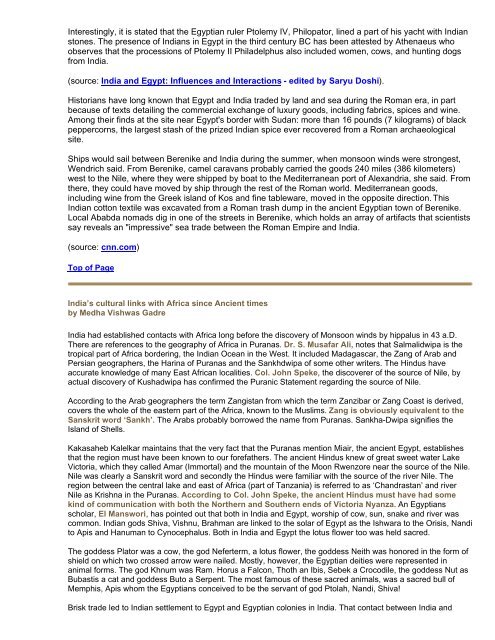A Tribute to Hinduism - India and Egypt - Mandhata Global
A Tribute to Hinduism - India and Egypt - Mandhata Global
A Tribute to Hinduism - India and Egypt - Mandhata Global
Create successful ePaper yourself
Turn your PDF publications into a flip-book with our unique Google optimized e-Paper software.
Interestingly, it is stated that the <strong>Egypt</strong>ian ruler P<strong>to</strong>lemy IV, Philopa<strong>to</strong>r, lined a part of his yacht with <strong>India</strong>n<br />
s<strong>to</strong>nes. The presence of <strong>India</strong>ns in <strong>Egypt</strong> in the third century BC has been attested by Athenaeus who<br />
observes that the processions of P<strong>to</strong>lemy II Philadelphus also included women, cows, <strong>and</strong> hunting dogs<br />
from <strong>India</strong>.<br />
(source: <strong>India</strong> <strong>and</strong> <strong>Egypt</strong>: Influences <strong>and</strong> Interactions - edited by Saryu Doshi).<br />
His<strong>to</strong>rians have long known that <strong>Egypt</strong> <strong>and</strong> <strong>India</strong> traded by l<strong>and</strong> <strong>and</strong> sea during the Roman era, in part<br />
because of texts detailing the commercial exchange of luxury goods, including fabrics, spices <strong>and</strong> wine.<br />
Among their finds at the site near <strong>Egypt</strong>'s border with Sudan: more than 16 pounds (7 kilograms) of black<br />
peppercorns, the largest stash of the prized <strong>India</strong>n spice ever recovered from a Roman archaeological<br />
site.<br />
Ships would sail between Berenike <strong>and</strong> <strong>India</strong> during the summer, when monsoon winds were strongest,<br />
Wendrich said. From Berenike, camel caravans probably carried the goods 240 miles (386 kilometers)<br />
west <strong>to</strong> the Nile, where they were shipped by boat <strong>to</strong> the Mediterranean port of Alex<strong>and</strong>ria, she said. From<br />
there, they could have moved by ship through the rest of the Roman world. Mediterranean goods,<br />
including wine from the Greek isl<strong>and</strong> of Kos <strong>and</strong> fine tableware, moved in the opposite direction. This<br />
<strong>India</strong>n cot<strong>to</strong>n textile was excavated from a Roman trash dump in the ancient <strong>Egypt</strong>ian <strong>to</strong>wn of Berenike.<br />
Local Ababda nomads dig in one of the streets in Berenike, which holds an array of artifacts that scientists<br />
say reveals an "impressive" sea trade between the Roman Empire <strong>and</strong> <strong>India</strong>.<br />
(source: cnn.com)<br />
Top of Page<br />
<strong>India</strong>’s cultural links with Africa since Ancient times<br />
by Medha Vishwas Gadre<br />
<strong>India</strong> had established contacts with Africa long before the discovery of Monsoon winds by hippalus in 43 a.D.<br />
There are references <strong>to</strong> the geography of Africa in Puranas. Dr. S. Musafar Ali, notes that Salmalidwipa is the<br />
tropical part of Africa bordering, the <strong>India</strong>n Ocean in the West. It included Madagascar, the Zang of Arab <strong>and</strong><br />
Persian geographers, the Harina of Puranas <strong>and</strong> the Sankhdwipa of some other writers. The Hindus have<br />
accurate knowledge of many East African localities. Col. John Speke, the discoverer of the source of Nile, by<br />
actual discovery of Kushadwipa has confirmed the Puranic Statement regarding the source of Nile.<br />
According <strong>to</strong> the Arab geographers the term Zangistan from which the term Zanzibar or Zang Coast is derived,<br />
covers the whole of the eastern part of the Africa, known <strong>to</strong> the Muslims. Zang is obviously equivalent <strong>to</strong> the<br />
Sanskrit word ‘Sankh’. The Arabs probably borrowed the name from Puranas. Sankha-Dwipa signifies the<br />
Isl<strong>and</strong> of Shells.<br />
Kakasaheb Kalelkar maintains that the very fact that the Puranas mention Miair, the ancient <strong>Egypt</strong>, establishes<br />
that the region must have been known <strong>to</strong> our forefathers. The ancient Hindus knew of great sweet water Lake<br />
Vic<strong>to</strong>ria, which they called Amar (Immortal) <strong>and</strong> the mountain of the Moon Rwenzore near the source of the Nile.<br />
Nile was clearly a Sanskrit word <strong>and</strong> secondly the Hindus were familiar with the source of the river Nile. The<br />
region between the central lake <strong>and</strong> east of Africa (part of Tanzania) is referred <strong>to</strong> as ‘Ch<strong>and</strong>rastan’ <strong>and</strong> river<br />
Nile as Krishna in the Puranas. According <strong>to</strong> Col. John Speke, the ancient Hindus must have had some<br />
kind of communication with both the Northern <strong>and</strong> Southern ends of Vic<strong>to</strong>ria Nyanza. An <strong>Egypt</strong>ians<br />
scholar, El Manswori, has pointed out that both in <strong>India</strong> <strong>and</strong> <strong>Egypt</strong>, worship of cow, sun, snake <strong>and</strong> river was<br />
common. <strong>India</strong>n gods Shiva, Vishnu, Brahman are linked <strong>to</strong> the solar of <strong>Egypt</strong> as the Ishwara <strong>to</strong> the Orisis, N<strong>and</strong>i<br />
<strong>to</strong> Apis <strong>and</strong> Hanuman <strong>to</strong> Cynocephalus. Both in <strong>India</strong> <strong>and</strong> <strong>Egypt</strong> the lotus flower <strong>to</strong>o was held sacred.<br />
The goddess Pla<strong>to</strong>r was a cow, the god Neferterm, a lotus flower, the goddess Neith was honored in the form of<br />
shield on which two crossed arrow were nailed. Mostly, however, the <strong>Egypt</strong>ian deities were represented in<br />
animal forms. The god Khnum was Ram. Horus a Falcon, Thoth an Ibis, Sebek a Crocodile, the goddess Nut as<br />
Bubastis a cat <strong>and</strong> goddess Bu<strong>to</strong> a Serpent. The most famous of these sacred animals, was a sacred bull of<br />
Memphis, Apis whom the <strong>Egypt</strong>ians conceived <strong>to</strong> be the servant of god P<strong>to</strong>lah, N<strong>and</strong>i, Shiva!<br />
Brisk trade led <strong>to</strong> <strong>India</strong>n settlement <strong>to</strong> <strong>Egypt</strong> <strong>and</strong> <strong>Egypt</strong>ian colonies in <strong>India</strong>. That contact between <strong>India</strong> <strong>and</strong>

















